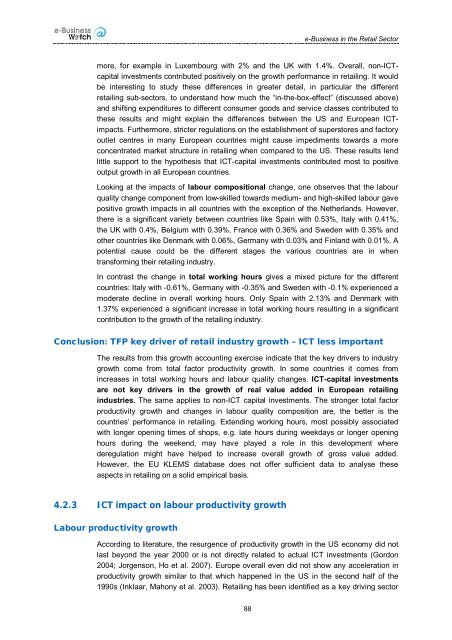ICT and e-Business Impact in the Retail Industry - empirica
ICT and e-Business Impact in the Retail Industry - empirica
ICT and e-Business Impact in the Retail Industry - empirica
- No tags were found...
You also want an ePaper? Increase the reach of your titles
YUMPU automatically turns print PDFs into web optimized ePapers that Google loves.
e-<strong>Bus<strong>in</strong>ess</strong> <strong>in</strong> <strong>the</strong> <strong>Retail</strong> Sectormore, for example <strong>in</strong> Luxembourg with 2% <strong>and</strong> <strong>the</strong> UK with 1.4%. Overall, non-<strong>ICT</strong>capital<strong>in</strong>vestments contributed positively on <strong>the</strong> growth performance <strong>in</strong> retail<strong>in</strong>g. It wouldbe <strong>in</strong>terest<strong>in</strong>g to study <strong>the</strong>se differences <strong>in</strong> greater detail, <strong>in</strong> particular <strong>the</strong> differentretail<strong>in</strong>g sub-sectors, to underst<strong>and</strong> how much <strong>the</strong> “<strong>in</strong>-<strong>the</strong>-box-effect” (discussed above)<strong>and</strong> shift<strong>in</strong>g expenditures to different consumer goods <strong>and</strong> service classes contributed to<strong>the</strong>se results <strong>and</strong> might expla<strong>in</strong> <strong>the</strong> differences between <strong>the</strong> US <strong>and</strong> European <strong>ICT</strong>impacts.Fur<strong>the</strong>rmore, stricter regulations on <strong>the</strong> establishment of superstores <strong>and</strong> factoryoutlet centres <strong>in</strong> many European countries might cause impediments towards a moreconcentrated market structure <strong>in</strong> retail<strong>in</strong>g when compared to <strong>the</strong> US. These results lendlittle support to <strong>the</strong> hypo<strong>the</strong>sis that <strong>ICT</strong>-capital <strong>in</strong>vestments contributed most to positiveoutput growth <strong>in</strong> all European countries.Look<strong>in</strong>g at <strong>the</strong> impacts of labour compositional change, one observes that <strong>the</strong> labourquality change component from low-skilled towards medium- <strong>and</strong> high-skilled labour gavepositive growth impacts <strong>in</strong> all countries with <strong>the</strong> exception of <strong>the</strong> Ne<strong>the</strong>rl<strong>and</strong>s. However,<strong>the</strong>re is a significant variety between countries like Spa<strong>in</strong> with 0.53%, Italy with 0.41%,<strong>the</strong> UK with 0.4%, Belgium with 0.39%, France with 0.36% <strong>and</strong> Sweden with 0.35% <strong>and</strong>o<strong>the</strong>r countries like Denmark with 0.06%, Germany with 0.03% <strong>and</strong> F<strong>in</strong>l<strong>and</strong> with 0.01%. Apotential cause could be <strong>the</strong> different stages <strong>the</strong> various countries are <strong>in</strong> whentransform<strong>in</strong>g <strong>the</strong>ir retail<strong>in</strong>g <strong>in</strong>dustry.In contrast <strong>the</strong> change <strong>in</strong> total work<strong>in</strong>g hours gives a mixed picture for <strong>the</strong> differentcountries: Italy with -0.61%, Germany with -0.35% <strong>and</strong> Sweden with -0.1% experienced amoderate decl<strong>in</strong>e <strong>in</strong> overall work<strong>in</strong>g hours. Only Spa<strong>in</strong> with 2.13% <strong>and</strong> Denmark with1.37% experienced a significant <strong>in</strong>crease <strong>in</strong> total work<strong>in</strong>g hours result<strong>in</strong>g <strong>in</strong> a significantcontribution to <strong>the</strong> growth of <strong>the</strong> retail<strong>in</strong>g <strong>in</strong>dustry.Conclusion: TFP key driver of retail <strong>in</strong>dustry growth – <strong>ICT</strong> less importantThe results from this growth account<strong>in</strong>g exercise <strong>in</strong>dicate that <strong>the</strong> key drivers to <strong>in</strong>dustrygrowth come from total factor productivity growth. In some countries it comes from<strong>in</strong>creases <strong>in</strong> total work<strong>in</strong>g hours <strong>and</strong> labour quality changes. <strong>ICT</strong>-capital <strong>in</strong>vestmentsare not key drivers <strong>in</strong> <strong>the</strong> growth of real value added <strong>in</strong> European retail<strong>in</strong>g<strong>in</strong>dustries. The same applies to non-<strong>ICT</strong> capital <strong>in</strong>vestments. The stronger total factorproductivity growth <strong>and</strong> changes <strong>in</strong> labour quality composition are, <strong>the</strong> better is <strong>the</strong>countries’ performance <strong>in</strong> retail<strong>in</strong>g. Extend<strong>in</strong>g work<strong>in</strong>g hours, most possibly associatedwith longer open<strong>in</strong>g times of shops, e.g. late hours dur<strong>in</strong>g weekdays or longer open<strong>in</strong>ghours dur<strong>in</strong>g <strong>the</strong> weekend, may have played a role <strong>in</strong> this development wherederegulation might have helped to <strong>in</strong>crease overall growth of gross value added.However, <strong>the</strong> EU KLEMS database does not offer sufficient data to analyse <strong>the</strong>seaspects <strong>in</strong> retail<strong>in</strong>g on a solid <strong>empirica</strong>l basis.4.2.3 <strong>ICT</strong> impact on labour productivity growthLabour productivity growthAccord<strong>in</strong>g to literature, <strong>the</strong> resurgence of productivity growth <strong>in</strong> <strong>the</strong> US economy did notlast beyond <strong>the</strong> year 2000 or is not directly related to actual <strong>ICT</strong> <strong>in</strong>vestments (Gordon2004; Jorgenson, Ho et al. 2007). Europe overall even did not show any acceleration <strong>in</strong>productivity growth similar to that which happened <strong>in</strong> <strong>the</strong> US <strong>in</strong> <strong>the</strong> second half of <strong>the</strong>1990s (Inklaar, Mahony et al. 2003). <strong>Retail</strong><strong>in</strong>g has been identified as a key driv<strong>in</strong>g sector88
















